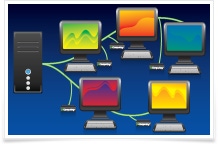More evidence is mounting that thin-clients, multi-user platforms and Virtual Desktop Infrastructure (VDI) are gaining critical mass. Two cases in point: Microsoft is teaming with NComputing on the multi-user front, and Microsoft will be in New York on Dec. 2 to discuss VDI solutions involving Windows 7. The VAR Guy is intrigued about both moves. Here's why.
December 1, 2009


microsoft_ncomputing
More evidence is mounting that thin-clients, multi-user platforms and Virtual Desktop Infrastructure (VDI) are gaining critical mass. Two cases in point: Microsoft is teaming with NComputing on the multi-user front, and Microsoft will be in New York on Dec. 2 to discuss VDI solutions involving Windows 7. The VAR Guy is intrigued about both moves. Here’s why.Remember: Microsoft used to promote a PC on every desktop and in every home. But a range of disruptive trends — thin clients, the Web, virtualization — has forced Microsoft to embrace new methods of computing.
In The VAR Guy’s mind, the Microsoft-NComputing relationship — announced a few days ago — is a big deal. NComputing’s hardware and software allow multiple terminals to access and share a single PC or server (as depicted in the NComputing illustration above).
NComputing says it will optimize its next generation of NComputing vSpace products for Microsoft’s server operating systems. It’s a neat deal aimed at a few goals, mainly money savings and energy savings for such vertical markets as schools, libraries and student labs. “All customers need is one easy Microsoft server operating system license for the host computer and appropriate client access licenses for each user station in order to run multiuser configurations,” Microsoft claims.
But how exactly does NComputing’s solution work? Here’s a quick overview:
“The U170 plugs into a [host] computer’s USB 2.0 port, and with NComputing vSpace software, enables additional users to share the excess resources on that computer. Each U170 delivers a high-definition multimedia experience and has connections for the user’s own monitor, speakers…and other USB peripherals.”
NComputing also has two other ‘series’ of these boxes, the L and the X. These devices work off Ethernet, instead of directly connecting via USB, and support more computers. (NComputing’s product page on TigerDirect.com calls it “The $73 PC.”)
Microsoft In Manhattan
Next up, Microsoft will tout Virtual Desktop Infrastructure (VDI) during a Dec. 2 luncheon in New York. Citrix and DynTek, a Microsoft Partner, will be on hand to help explain how and why customers should potentially migrate to a VDI infrastructure running Windows 7.
The VAR Guy plans to attend, and will arrive with a hearty appetite and plenty of VDI questions for Microsoft and its partners.
Heading for Home?
Back in August 2009, The VAR Guy openly wondered if 2010 would be the year of desktop virtualization and VDI projects. Fast forward to the present, and our resident blogger now wonders if such technologies will increasingly move into the home.
While VDI won’t replace the laptop, imagine a household with one beefy computer in a closet and a few thin-clients floating around in bedrooms and your home office. Or imagine an office complex where there’s only one or two server computers to update instead of maintaining individual machines. Everyone gets the same software, hardware; backup is a breeze. It’s essentially on-site cloud computing.
Assuming, that is, the solutions work as advertised…
Follow The VAR Guy via RSS; Facebook; Identi.ca; Twitter; and via his Newsletter; Webcasts and Resource Center. Plus, check out more channel voices at www.vartweet.com.
About the Author(s)
You May Also Like


